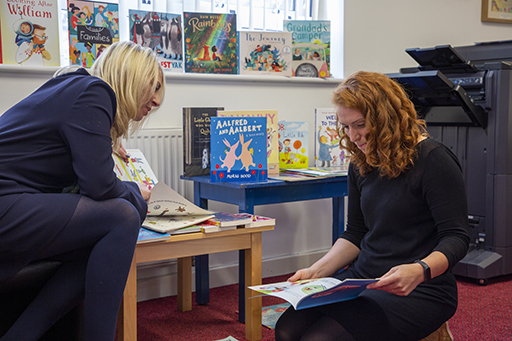4 Reader relationships across the school
Reading Teachers do not need to be classroom teachers. Headteachers, teaching assistants, reading volunteers, librarians, and parents – all adults – can reflect upon and share their engagement in texts as fellow readers. However, headteachers have a particularly important role to set the tone and lead by example as authentic, engaged readers.
In reflecting upon both their print and digital reading lives, adults are likely to widen their conceptions of reading and what it means to be a reader in the 21st century. This will help to create more inclusive reading communities, where all texts are valued and where all adults share the value, pleasure and satisfaction in being readers. In this way they can instil a love of reading in the young.

Children benefit from seeing their teacher and other adults as recreational readers, but, crucially, this needs to made very visible to them (Merga, 2016). Displays can help, but children are also helped by seeing and hearing adults discussing what they’re reading and observing the swapping/loaning of texts genuinely reader to reader. There are multiple ways for adults and children to share their reading lives together in class, at home or in assembly, some of which are shown in Box 1. Using these ideas can help to showcase the delight to be found in reading and also demonstrate the differences and commonalities in reading, with many text types and readers.
Box 1 Ideas for sharing and showcasing readers’ lives, preferences and practices
- Who reads in our homes?
Everyone is invited to take photos of themselves and family members reading at home.
- Why bother?
Readers from across the school share their views on why they read and their favourite text type/s.
- Old, gold and never sold
Readers share books they adore and cannot be parted from, from childhood or more recently and explain why.
- Readers in disguise
Staff take photos of themselves reading, but in disguise. Children then guess who they are, based on the text and knowledge of staff.
- Guess the shelfie
Staff take photos of a bookshelf (bedside table, pile of texts from home, etc.) and get the children to guess whose shelf is whose, based on knowledge of staff.
- Reading histories
Readers create posters/PowerPoints of beloved reading from the past.
- 24-hour reads
Everyone creates a collage of what they read across a 24-hour period.
- Extreme reading
Everyone takes photos of themselves or family members reading in unusual places.
Within a school-wide focus on building reader relationships and communities such opportunities, like those listed in Box 1, are invaluable. Alongside work on staff knowledge of texts and readers, and RfP pedagogy, such wider sharing is essential to help build reader-to-reader relationships across the school.
Activity 3 Sharing reading lives
Choose one of the ideas listed in Box 1 and try it out in your class or school. Make a note of what happened, then respond to the questions below.
- How many different kinds of texts were evident?
- Could your class categorise these? E.g. magazines, comics, social media, non-fiction, fiction, emails, etc.
- What did the experience of participating reveal about the readers? What differences and commonalities were evident?
Comment
Everyone’s reading life and identity are unique; everyone has different interests in life and often you read in relation to these, to serve your own goals. Nonetheless, there will be areas of commonality and connection, which can trigger sharing amongst staff and children, and between children.
Research suggests young people are motivated by a desire to belong, and that social and relational support for reading is particularly beneficial to less engaged or reluctant readers. Such readers may become disheartened if reading is positioned as a competition, with gold stars or stickers being awarded (Orkin et al., 2018). Unenthusiastic readers need support to build their assurance, texts to tempt them and opportunities to engage socially with adults and children. Social motivation, as noted in Session 2, influences reader engagement, and can be supported by volunteer reading helpers.
